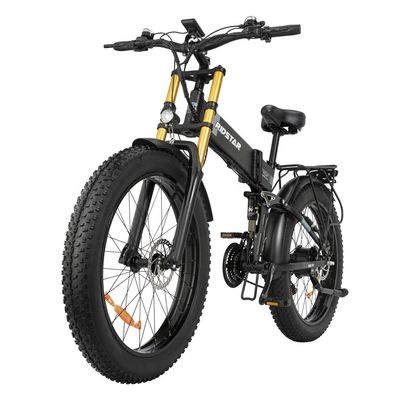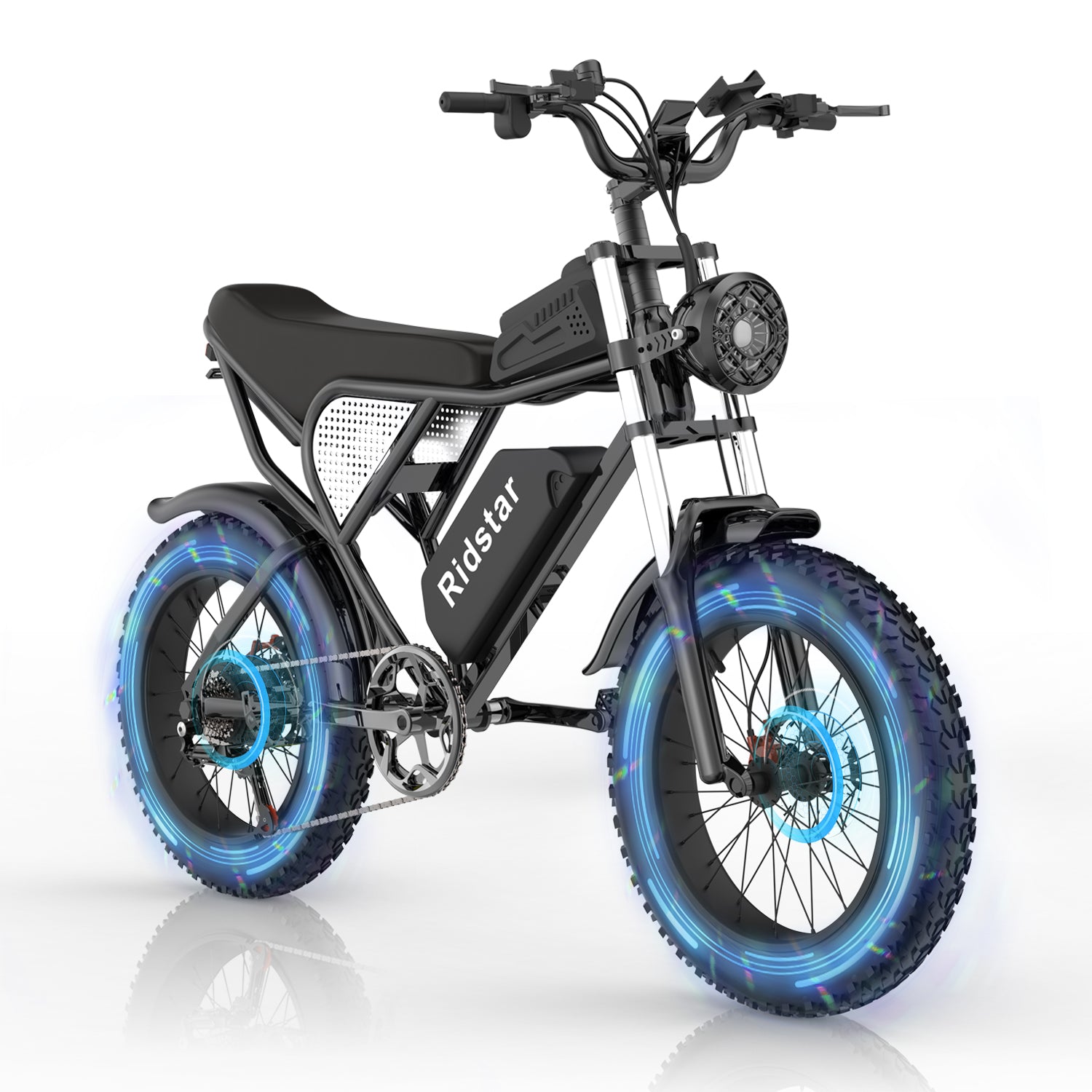A Comprehensive Guide to Choosing Your First Ebike
Embarking on the journey of purchasing your first ebike can be both exciting and overwhelming. With a multitude of options available in the market, from different brands to various styles and features, it's essential to make an informed decision. This guide aims to provide beginners with a comprehensive overview of how to choose the right ebike, considering factors such as budget, riding preferences, components, and more. By the end of this guide, you'll feel confident in selecting an ebike that perfectly suits your needs and preferences.
Understanding Your Needs and Preferences: Before diving into the specifics of ebike models, it's crucial to understand your own needs and preferences. Ask yourself the following questions:
- What will be the primary purpose of my ebike? Commuting, leisure rides, off-road adventures, or a combination?
- What is my budget range for purchasing an ebike?
- Do I have any specific preferences regarding bike style, such as mountain bike, cruiser, folding bike, or hybrid?
- How far do I plan to ride on a single charge?
- Are there any particular features or components that are essential to me, such as motor power, battery capacity, or comfort accessories?
Once you have a clear understanding of your needs and preferences, you can start exploring the various options available in the market.
Researching Different Ebike Types: Ebikes come in various styles and designs, each tailored to different riding experiences. Here are some common types of ebikes to consider:
-
Commuter Ebikes: Designed for urban commuting, these ebikes typically feature a lightweight frame, narrow tires, and an upright riding position for comfort and agility in city environments.
-
Mountain Ebikes (eMTBs): Built for off-road adventures, mountain ebikes feature rugged frames, suspension systems, and knobby tires to tackle challenging terrains with ease. They often come with powerful motors and long-lasting batteries to support extended rides on trails.
-
Cruiser Ebikes: Perfect for leisurely rides along the beach or through the neighborhood, cruiser ebikes feature a relaxed riding position, wide handlebars, and comfortable saddles. They are ideal for casual riders looking for a laid-back cycling experience.
-
Folding Ebikes: Ideal for commuters with limited storage space, folding ebikes can be easily folded and stored in small apartments or offices. Despite their compact size, they offer decent performance and versatility for urban commuting.
-
Hybrid Ebikes: Combining the features of commuter and mountain ebikes, hybrid ebikes offer a versatile riding experience suitable for both city streets and light off-road trails. They typically feature a hybrid frame geometry, medium-width tires, and moderate suspension for all-around performance.
Consider your intended riding environment and preferences to determine which type of ebike best suits your needs.
Understanding Ebike Components: When evaluating different ebike models, it's essential to understand the key components that contribute to their performance and functionality. Here are some critical components to consider:
-
Motor: The motor is the heart of an ebike, providing pedal-assist or throttle power to propel the bike forward. Motors are typically classified based on their location (hub motor or mid-drive motor) and power output (measured in watts). Hub motors are located in the wheel hub and are popular for their simplicity and affordability, while mid-drive motors are integrated into the bike's frame and offer better balance and efficiency, especially for climbing hills.
-
Battery: The battery is responsible for storing and supplying the energy needed to power the motor. Battery capacity is measured in watt-hours (Wh), indicating the amount of energy the battery can store. Higher capacity batteries generally offer longer range, allowing you to ride farther on a single charge. When choosing an ebike, consider the battery's voltage, ampere-hour (Ah) rating, and chemistry (e.g., lithium-ion) for optimal performance and longevity.
-
Controller: The controller regulates the flow of electricity between the battery and the motor, controlling the ebike's speed and power output. High-quality controllers offer smooth and responsive acceleration, as well as advanced features such as regenerative braking and customizable ride settings.
-
Frame: The frame is the backbone of the ebike, providing structural support and stability during rides. When selecting an ebike, consider factors such as frame material (e.g., aluminum, carbon fiber, steel), frame geometry (e.g., step-through, diamond), and sizing to ensure a comfortable and efficient riding experience.
-
Brakes: Brakes are essential for stopping and controlling the ebike, especially at high speeds or when riding downhill. Common brake types include rim brakes, disc brakes, and hydraulic disc brakes, each offering different levels of stopping power and modulation. Choose brakes that are suitable for your riding style and terrain, prioritizing safety and reliability.
-
Drivetrain: The drivetrain consists of the components that transmit power from the motor to the wheels, including the chain, cassette, derailleur, and crankset. Higher-end ebikes often feature premium drivetrain components from reputable brands like Shimano or SRAM, offering smooth and precise shifting for enhanced performance and efficiency.
-
Wheels and Tires: Wheels and tires play a crucial role in the ebike's ride quality, handling, and traction. Consider factors such as wheel size (e.g., 26-inch, 27.5-inch, 29-inch), tire width (e.g., narrow for road riding, wide for off-road trails), and tread pattern (e.g., slick for pavement, knobby for trails) to match your riding preferences and terrain.
Evaluating Performance and Specifications: Once you have a basic understanding of ebike components and types, it's time to evaluate the performance and specifications of different models. Here are some key factors to consider:
-
Motor Power: Choose a motor with sufficient power output to meet your riding needs, whether it's for casual commuting or tackling steep hills. Motors typically range from 250 watts (legal limit in many regions) to 750 watts or more for high-performance models.
-
Battery Range: Consider the ebike's estimated range on a single charge, taking into account factors such as battery capacity, motor efficiency, terrain, and rider weight. Choose a battery with enough capacity to cover your daily commute or recreational rides without running out of power.
-
Speed and Assist Levels: Determine the maximum assisted speed and available assist levels of the ebike, ensuring they align with your local regulations and riding preferences. Some ebikes offer multiple assist modes (e.g., eco, normal, sport) for customizable riding experiences.
-
Weight and Portability: Consider the weight of the ebike, especially if you need to lift or transport it regularly. Lightweight and folding ebikes are ideal for commuters who need to carry their bikes up stairs or onto public transportation.
-
Comfort and Ergonomics: Pay attention to the ebike's comfort features, such as saddle design, handlebar shape, and suspension system. A comfortable riding position and ergonomic design can significantly enhance your overall riding experience, especially during long rides.
-
Additional Features: Explore any additional features or accessories offered with the ebike, such as integrated lights, fenders, racks, and electronic displays. These extras can add convenience, safety, and versatility to your rides, enhancing your overall satisfaction with the bike.
Testing and Comparison: Once you've narrowed down your options based on your needs, preferences, and budget, it's time to test ride and compare different ebike models. Visit local bike shops or attend ebike demo events to test ride various models and assess their performance, comfort, and handling. Pay attention to factors such as acceleration, braking, steering responsiveness, and overall ride quality.
During your test rides, take note of any specific features or components that stand out to you, as well as any potential drawbacks or concerns. Don't hesitate to ask questions and seek advice from knowledgeable staff or fellow riders to make an informed decision.
Comparing Prices and Reviews: In addition to test riding ebikes, it's essential to research and compare prices, specifications, and customer reviews online. Visit manufacturer websites, online retailers, and ebike forums to gather information about different models and their respective pros and cons.
Pay attention to factors such as warranty coverage, customer support, and availability of replacement parts when comparing ebike brands and models. Reading reviews and testimonials from other riders can provide valuable insights into real-world experiences with specific ebikes, helping you make a more informed decision.
Making Your Decision: After thoroughly researching, testing, and comparing different ebike models, it's time to make your final decision. Choose the ebike that best meets your needs, preferences, and budget, taking into account factors such as performance, comfort, reliability, and value for money.
Once you've selected your ideal ebike, consider additional accessories or upgrades to enhance your riding experience, such as helmets, locks, lights, and cargo racks. Remember to prioritize safety and responsible riding practices, adhering to local traffic laws and regulations while enjoying your new ebike adventures.
Conclusion: Choosing your first ebike is an exciting and rewarding process that requires careful consideration of your needs, preferences, and budget. By understanding the different types of ebikes, key components, and performance factors, you can make an informed decision that will provide you with years of enjoyable riding experiences.
Whether you're commuting to work, exploring scenic trails, or simply enjoying leisurely rides around town, your ebike will open up a world of possibilities and adventures. With the right combination of features, comfort, and reliability, your first ebike will become a trusted companion on your cycling journey for years to come. Happy riding!



